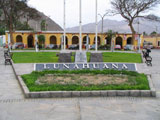|
Lunahuana
| |
Photo-report by Irina and Dmitry Nazarov (April, 2006) |
|
 If a citizen of Lima wants to relax from the capital's fuss and get some new impressions while avoiding spending much time on travelling, he or she goes to Lunahuana (the last syllable is stressed). It takes only two hours to get there. Not only Peruvians but also foreign tourists are quite familiar with this place located at the altitude of 479 m above sea level. The ambient air temperature never goes lower than 20 degrees Centigrade, and therefore one can go in for summer sports here throughout the year.
If a citizen of Lima wants to relax from the capital's fuss and get some new impressions while avoiding spending much time on travelling, he or she goes to Lunahuana (the last syllable is stressed). It takes only two hours to get there. Not only Peruvians but also foreign tourists are quite familiar with this place located at the altitude of 479 m above sea level. The ambient air temperature never goes lower than 20 degrees Centigrade, and therefore one can go in for summer sports here throughout the year.
|
 |
|
|
 |
|
The Cañete river is a paradise for those who are ford of rafting. The sportsmen are offered the rafting routes of up to the 5th level of difficulty. Of course, "dummies" will not be allowed to go along any dangerous routes. We rafted down the river on the second-level routes, and that was quite enough for getting strong impressions and callosities on our hands because of rowing.
On the first Sunday of March, a Peruvian national rafting event takes place here (it is called "canotaje" – a derivative from the word "canoe"). This event coincides with the wine festival (at this time of the year, new wine is already available for consumption), and therefore merriment is at its utmost. Those who are eager to get some strong impressions are also offered here to ride on horseback or to go mountaineering. However, the range of possible tourist activities in this region is not limited to the above.
|
 |
|
|
 |
|
Those who are interested in the pre-Columbus culture are offered to visit a wonderful place - Incahuasi. This is one of the few remaining Inca constructions on the Peruvian coast. In 1553, the historian Pedro Cieza de Leon called this place "New Cusco." Incahuasi was built by the emperor Inca Tupa Yupanqui late in the 15th century. At that time, the emperor was engaged in a protracted warfare with the tribe called Huarco, and Incahuasi was needed as a military base.
As Cieza de Leon writes, Cusco was really used as a model for the new town being built. However, there exists another historical version: when constructing new towns, the Inca people often called them "Cusco." The military base was built within a short period of time and was used only until the Huarco tribe was defeated. Then the base was abandoned.
 The construction materials were quite simple – granite fragments and clay. The buildings were used for various applications: there were rooms for living, rituals, and food storage. Palaces for noblesse were also built. Unfortunately, as is often the case in many other Peruvian "historic places," there are no inscriptions or indicators, and therefore tourists have to guess what kind of ruins they are visiting.
The construction materials were quite simple – granite fragments and clay. The buildings were used for various applications: there were rooms for living, rituals, and food storage. Palaces for noblesse were also built. Unfortunately, as is often the case in many other Peruvian "historic places," there are no inscriptions or indicators, and therefore tourists have to guess what kind of ruins they are visiting.
 Incahuasi, like any other towns of the Inca people, was connected to other towns by roads. We saw one of such roads on the opposite bank of the Canete river. As nobody could tell us what kind of road it was, we decided to call it "The Road of the Inca people."
Incahuasi, like any other towns of the Inca people, was connected to other towns by roads. We saw one of such roads on the opposite bank of the Canete river. As nobody could tell us what kind of road it was, we decided to call it "The Road of the Inca people."

 The colonial era buildings that produce quite an impression include the ruins of the church called Capilla de la Virgen de la Asuncion, which was built by the Franciscans in the 16th century, when Pizarro gave the conquistador Diego De Aguero a part of the valley for use. The remnants of the alter on the background of the mountains produce a lasting impression.
The colonial era buildings that produce quite an impression include the ruins of the church called Capilla de la Virgen de la Asuncion, which was built by the Franciscans in the 16th century, when Pizarro gave the conquistador Diego De Aguero a part of the valley for use. The remnants of the alter on the background of the mountains produce a lasting impression.
 The guidebooks recommend visiting the hanging bridge called Catapalla. Everybody knows that the Inca people were wonderful builders of hanging bridges. It seems that there was no abyss or mountain river that could block their way. Moreover, not only were the bridges skillfully built, but were also constantly kept in excellent state due to the efficiency of functioning of the Inca's empire. The inhabitants of the village that was located closest to a bridge were obliged to take a good care of the bridge and to repair it if necessary. Even after this country was captured by Spaniards, many of the Inca-built bridges kept providing reliable service to local people for several centuries, although there was nobody who would service them. It is quite probable that because of this the most beautiful bridge of Peru - Bridge of San Luis Rey – collapsed in the novel of the same name written by Thornton Wilder. The bridge in Lunahuana built in 1932 is far from being an engineering masterpiece, but it looks quite nice on the background of the wonderful local landscape.
The guidebooks recommend visiting the hanging bridge called Catapalla. Everybody knows that the Inca people were wonderful builders of hanging bridges. It seems that there was no abyss or mountain river that could block their way. Moreover, not only were the bridges skillfully built, but were also constantly kept in excellent state due to the efficiency of functioning of the Inca's empire. The inhabitants of the village that was located closest to a bridge were obliged to take a good care of the bridge and to repair it if necessary. Even after this country was captured by Spaniards, many of the Inca-built bridges kept providing reliable service to local people for several centuries, although there was nobody who would service them. It is quite probable that because of this the most beautiful bridge of Peru - Bridge of San Luis Rey – collapsed in the novel of the same name written by Thornton Wilder. The bridge in Lunahuana built in 1932 is far from being an engineering masterpiece, but it looks quite nice on the background of the wonderful local landscape.
Of course, it is worth while paying attention to the central square of Lunahuana. Although it differs little from other provincial centers, its Colonial Church (it is called like this!) - La Iglesia Colonial - looks quite nice on the background of the mountains. One can have lunch at a restaurant that offers a complete variety of local cuisine. This place is famous for its river shrimps that look like crayfish (unfortunately, these are just crayfish, but with a big claw), trout, wine, and pisco.
 Those who are fond of strong impressions can visit the local bewitched house - la Casa Encantada. This simple-architecture building was constructed in 1950, and ever since nobody stayed therein for long. Its first owner was certain Vladimir Garbin, an Italian, who settled in the bewitched house together with his young wife. According to a legend, they soon had to leave because they were not able to fall asleep at night: the doors and windows opened and closed by themselves with a loud noise. Then the inhospitable house saw a number of new owners, until it was finally abandoned. As is told, at midnight one can hear cries for help coming out of the basement that used to be a wine cellar. Should you decide to visit this horrible place at night, do not respond to the cries for help, otherwise...
Those who are fond of strong impressions can visit the local bewitched house - la Casa Encantada. This simple-architecture building was constructed in 1950, and ever since nobody stayed therein for long. Its first owner was certain Vladimir Garbin, an Italian, who settled in the bewitched house together with his young wife. According to a legend, they soon had to leave because they were not able to fall asleep at night: the doors and windows opened and closed by themselves with a loud noise. Then the inhospitable house saw a number of new owners, until it was finally abandoned. As is told, at midnight one can hear cries for help coming out of the basement that used to be a wine cellar. Should you decide to visit this horrible place at night, do not respond to the cries for help, otherwise...
One can enjoy the beautiful flora and fauna of Lunahuana even without leaving the hotel.
|






















